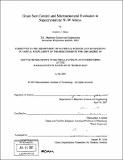Grain size control and microstructural evolution in nanocrystalline Ni-W alloys
Author(s)
Detor, Andrew J. (Andrew Joseph)
DownloadFull printable version (34.35Mb)
Other Contributors
Massachusetts Institute of Technology. Dept. of Materials Science and Engineering.
Advisor
Christopher A. Schuh.
Terms of use
Metadata
Show full item recordAbstract
Nanocrystalline materials have been studied extensively over the past two decades because of their useful and interesting physical properties. In most cases, these properties derive from the fine characteristic length scale of nanocrystalline structures and are superior to those realized in traditional coarse-grained materials. A fundamental challenge, however, involves the synthesis of high-quality specimens, which represent a classical far-from-equilibrium state due to the large presence of high-energy interfaces. Alloying presents a possibility to reduce this energy penalty through solute segregation and thermodynamic stabilization of the grain boundaries. The present work exploits this concept in the nanocrystalline Ni-W system. Atomistic computer simulations are used to evaluate the potential for stabilization based on the equilibrium solute distribution and energetics of nanocrystalline structures. Following this, a synthesis technique based on electrodeposition is developed where precise control over the alloying addition correlates with precise control over grain size. (cont.) Investigations of the microstructure involving techniques such as transmission electron microscopy, x-ray diffraction, and atom probe tomography provide a detailed view of the structure and solute distribution in these materials, and the results are compared with atomistic simulations and thermodynamic models of nanostructure stabilization. The elevated temperature behavior of experimental specimens is also evaluated and compared to analytical models of microstructural evolution, showing that grain boundary relaxation is an important mechanism for the finest nanocrystalline grain sizes, having a significant influence on properties. With a new degree of control over the nanostructure, Ni-W alloys are produced over a broad range of grain sizes to investigate hardness trends and the breakdown of a classical scaling law in the nanocrystalline regime. An extension of the synthesis technique is also demonstrated for the production of functionally graded and nano-scale composite materials. Potential benefits of the methods developed in this work are highlighted for both fundamental scientific investigations and practical applications.
Description
Thesis (Ph. D.)--Massachusetts Institute of Technology, Dept. of Materials Science and Engineering, 2007. Includes bibliographical references (leaves 119-131).
Date issued
2007Department
Massachusetts Institute of Technology. Department of Materials Science and EngineeringPublisher
Massachusetts Institute of Technology
Keywords
Materials Science and Engineering.